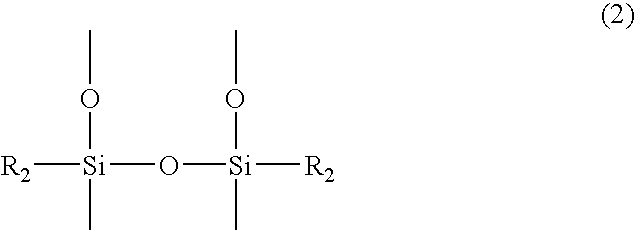Silicone resin and photosensitive resin composition containing the same
a technology of photosensitive resin and silicon resin, which is applied in the field of silicon resin and photosensitive resin composition, can solve the problems of reducing the depth of focus (dof) with a drop in sensitivity and aspect ratio
- Summary
- Abstract
- Description
- Claims
- Application Information
AI Technical Summary
Problems solved by technology
Method used
Image
Examples
example 1
Phenylsilsesquioxane containg glycidyl group was synthesized with reference to Reference Example 1 and Example 3 described in PCT / JP98 / 01098 (WO98 / 41566) and JP 10-251407 (1998)A1.
synthetic example 1
Synthesis of Cage Type Octaphenylsilsesquioxane
In 500 cc of toluene was dissolved 105 g (0.5 mole) of phenyltrichlorosilane and the mixture was shaken with water until the hydrolysis was completed. The hydrolysis product was washed with water, mixed with 16.6 cc (0.03 mole) of commercially available 30% methanol solution of benzyltrimethylammonium hydroxide, and the mixture was heated at reflux temperature for 4 hr.
Thereafter, the whole mixture was cooled and left standing for approximately 96 hr. After this time elapsed, the resulting slurry was again heated at reflux temperature for 24 hr, cooled, and filtered to give about 75 g of cage type octaphenylsilsesquioxane (C.sub.6 H.sub.5 SiO.sub.3 / 2).sub.8. In infrared spectrometry of the product, absorption bands assignable to Si--C.sub.6 H.sub.5 were observed at 1595 cm.sup.-1 and 1430 cm.sup.-1 and an absorption band assignable to the antisymmetric stretching vibration of Si--O--Si was observed at 1135 cm.sup.-1 while an absorption ...
synthetic example 2
Synthesis of Phenylsilsesquioxane Oligomer Containing Glycidyl Group
To a reaction vessel were added 100 g of the cage type octaphenylsilsesquioxane, 70.3 g of 1,3-bis(3-glycidoxypropyl)-1,1,3,3-tetramethyldisiloxane, 400 g of toluene, and 4 g of tetramethylammonium hydroxide pentahydrate and the mixture was heated at reflux temperature with vigorous stirring for 7 hr. The reaction mixture was a white suspension at the start because white powders of the the cage type octaphenylsilsesquioxane did not dissolve in toluene, but the powders gradually dissolved as the reaction progressed and nearly all of them dissolved after 7 hr to give a colorless transparent solution. The solution was cooled to room temperature, a precipitate of the unreacted tetramethylammonium hydroxide was removed by filtration, and the filtrate was poured into 2,000 g of excess methanol to reprecipitate phenylsilsesquioxane containing a terminal glycidoxy group. The viscous precipitate was washed with methanol and ...
PUM
| Property | Measurement | Unit |
|---|---|---|
| Electrical resistance | aaaaa | aaaaa |
| Molecular weight | aaaaa | aaaaa |
| Photosensitivity | aaaaa | aaaaa |
Abstract
Description
Claims
Application Information
 Login to View More
Login to View More - R&D
- Intellectual Property
- Life Sciences
- Materials
- Tech Scout
- Unparalleled Data Quality
- Higher Quality Content
- 60% Fewer Hallucinations
Browse by: Latest US Patents, China's latest patents, Technical Efficacy Thesaurus, Application Domain, Technology Topic, Popular Technical Reports.
© 2025 PatSnap. All rights reserved.Legal|Privacy policy|Modern Slavery Act Transparency Statement|Sitemap|About US| Contact US: help@patsnap.com



